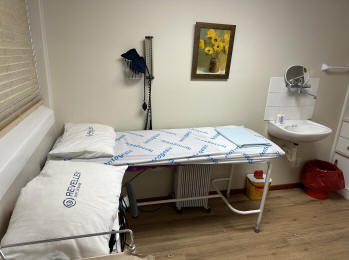 The
examination room
The
examination room
 The
examination room The
examination room
|
|
|
The examination is the fundamental part of
all rheumatology. The process is more important than blood tests or
X-rays, all of which might be completely normal in the face of
abnormality or disease.
I usually request female patients to take their clothes off except bra and panty and put a gown on - open to the back. If I feel it is relevant, I may ask a patient to remove the bra, in order to perform a breast examination to exclude breast malignancy. Breast malignancy is a potential cause of secondary bone cancer, and not examining the breasts may boccasionally required. In addition there are issues relating to hormone therapy, that may require breast examination. Maintain dignity Once undressed the patient MUST be properly
covered - with gown (for females) and covered with a sheet.
General examination I perform a full general examination.
Pulse, Blood pressure and peripheral circulation. Examination for Glands (lymph nodes), skin
rashes, pallor or anemia, oxygenation of the tissues, examination of
nails and the peripheries, examination for fluid retention - oedema.
Examination of the heart. Examination of the abdomen. Examination of the neurological system - A VITAL
examination. Examination of the urine.
Muscle/joint examination We examine ALL the joints.
Feel the joints Move the joints We take each joint through it's range of movement. Assessment is made of damage and contracture, as well as induction and reproduction of pain. We also feel for crepitus on movement of the joints. Active movement - is tested by making the patient move the joint through it's range of movement. This utilises joint and the soft tissue, and therefore acts as a screen for a musculoskeletal problem. Passive movement - is movement WITHOUT the patient contracting the muscles. The movement is conducted without patient assistance. If pain is induced - then the problem is NOT muscle or soft tissue origin, but lies within the joint itself Resisted movement - is movement of the limb or joint in a specific direction upon request and against the resistance of the examiner. This therefore makes the patient contract a specified muscle structure. It is therefore the best test of disease of the soft tissue around the joint - such as muscles. Make a provisional diagnosis Once the examination is concluded, the suspicions obtained by the history, are confirmed or further suspected, and a diagnosis or potential diagnosis should already have been made by the doctor. A list of potential diagnoses - the differential diagnosis, should already be in the mind of the doctor, and it is only to confirm or assist in coming to a definitive diagnosis, that blood tests or X-rays may be requested.
Go to the rheumatology examination
|